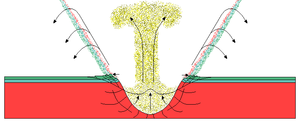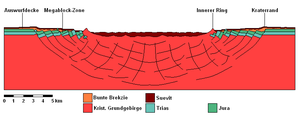Secondary crater
In astronomy and planetology, secondary craters are small impact craters on a planet or moon that are created as a by-product of a large impact .
| Formation of a crater with a central ring structure |
|---|

|

|

|

|

|
They can have two causes:
- ejected impact or rock fragments during the impact
- the bursting of the large body of the impact into several parts just before the impact.
On moons and other celestial bodies without a gas shell, almost only the first cause comes into question. When penetrating an atmosphere, however, the processes are more diverse:
- Small meteoroids that z. B. hit the earth, burn up or burst at great heights
- Medium-sized objects only heat up later and therefore only burst at lower heights. The secondary craters arising from the smaller fragments are generally distributed randomly around the area.
- Larger objects from a few 100 tons are slowed down by air resistance late and reach the earth's surface - depending on the original orbit in the solar system - at 10 to 70 km / s. Upon impact, they penetrate the rock and evaporate instantly. The surrounding material is blasted away and creates a circular explosion crater , regardless of the angle of impact. The ejected material forms the so-called ejecta ceiling around the new crater . On the other hand, if it contains larger chunks, secondary craters also form. This situation can be seen in the middle picture on the right.
With a larger number of fragments, small rows of craters can also arise.
Literature and Sources
- Eugene Shoemaker , Margit Röser: Collision of Solid Bodies , Chapter 4 in K. Beatty et al., The sun and its planets . Physik-Verlag, Weinheim 1983
- J. Pohl, H. Gall: Construction and origin of the Ries crater . Geologica Bavarica, Vol. 76, Munich, 1977
- About the sketch: User Vesta (2005) and R. Hüttner, H. Schmidt-Kaler, Die Geologische Karte des Rieses 1: 50000, with explanations of the origin of the crater. Geologica Bavarica, Vol. 104, Munich, 1999.